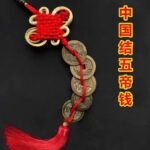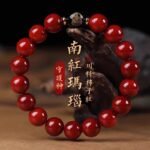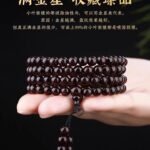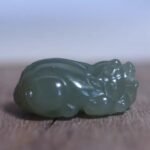Hey Jade Lovers! Don’t Let Faux Shine Fool You
Imagine this: you spot a gleaming, milky-white carving labeled “jade”—and the price? Too good to be true. That’s your cue: you might be holding Afghan Jade, a beautiful stone often mistaken for the real deal.
But is it Nephrite or Jadeite, the legendary, emperor-loved jade revered by Taoists and collectors alike? Or something else entirely?
Let’s unmask Afghan Jade and discover how to tell it apart from authentic jade—so you shop smart and invest in true value.
What Is Afghan Jade… Really?
Despite the luxurious name, Afghan Jade is not true jade.
According to GIA, only two minerals can officially be called jade:
- Nephrite (calcium magnesium iron silicate)
- Jadeite (sodium aluminum silicate)
Afghan Jade, on the other hand, is usually one of the following:
- Calcite (aka marble): A soft, pretty stone with a Mohs hardness of 3, much lower than real jade. Mindat.org – Calcite confirms this.
- Serpentine: Sometimes called “new jade,” serpentine has a green tone but still isn’t nephrite or jadeite.
- Other aliases: Watch out for names like “Pakistan Jade,” “Onyx Marble,” or “White Onyx.” These are trade terms, not mineralogical identities.
Afghanistan is known for producing beautiful carvable calcite, hence the misleading term “Afghan Jade.”
Afghan Jade vs. Real Jade: Key Differences
| Feature | Afghan Jade (Calcite/Marble) | Real Jade (Nephrite/Jadeite) |
|---|---|---|
| Composition | Calcium carbonate / serpentine | Silicates (Nephrite or Jadeite) |
| Hardness | Mohs 3–4 (scratches easily) | Mohs 6–7 (very tough) |
| Luster | Waxy to dull | Oily to glassy (especially jadeite) |
| Density | Light for its size | Dense, heavy |
| Touch | Can feel chalky or waxy | Cool, smooth, “greasy” (nephrite’s signature) |
| Transparency | Sometimes highly translucent | Often translucent, with more depth and glow |
| Sound Test | Dull “thud” when tapped | Clear, high-pitched chime |
| Price | Affordable | High (especially for fine jadeite or nephrite) |
Want to learn how to spot fake jade with practical tips? Check out our guide:
🟩 How to Spot Fake Hetian Jade (5 Types)
Why Is Afghan Jade So Common?
- Looks Great: Its milky white and soft green shades make it visually similar to lower-grade nephrite.
- Low Cost: It’s far cheaper and easier to carve, making it perfect for decorative objects.
- Marketing Confusion: Many sellers misuse the term “jade” to suggest higher value.
How to Identify Afghan Jade Like a Pro
✔️ Scratch Test (with care): Real jade won’t scratch easily with a knife. Afghan Jade? It’ll show marks fast.
✔️ Weight Test: Nephrite and jadeite feel heavy for their size. Afghan Jade is much lighter.
✔️ Luster Check: Genuine jade has a rich, deep glow. Afghan Jade is often waxy or cloudy.
✔️ Touch & Feel: True jade feels cool and dense. Calcite warms up fast and feels less smooth.
✔️ Price Check: If a huge, intricately carved “jade” piece costs under $100… it’s probably not real jade.
✔️ Ask Sellers Clearly: Ask: “Is this Nephrite or Jadeite?” If they dodge the question, it’s a red flag.
💡 Dive deeper into jade types here:
🧭 Xinjiang, Qinghai, and Russian Hetian Jade — A Friendly Comparison
Afghan Jade Is Still Beautiful—Just Be Informed
Let’s be clear: Afghan Jade isn’t “bad”—it’s simply not true jade. As long as you know what you’re getting, it can be a great, affordable decorative stone. Trouble starts when it’s misrepresented.
Crave the Real Thing? Explore Authentic Jade at My Story of Orient
At My Story of Orient, we specialize in authentic Hetian Jade—especially prized Russian nephrite—and offer clear guidance so you can buy with confidence.
✨ Related reads for smart jade collectors:
- Avoid These 3 Mistakes When Buying Hetian Jade
- The 3 Faces of Beauty: How Hetian Jade Gets Its Shine
- Why Taoists Revere Hetian Jade
Final Words: Know What You’re Buying, Love What You Own
To sum it up: Afghan Jade = beautiful, but not real jade.
If you’re a collector or simply love Oriental culture, investing in genuine jade means getting something timeless—both in beauty and in spirit.
🛍️ Shop smart. Choose authenticity. Explore real jade treasures at My Story of Orient



